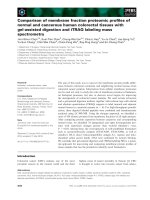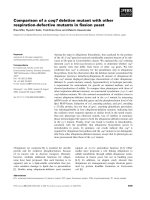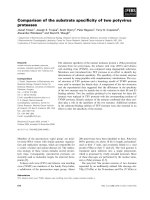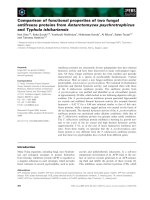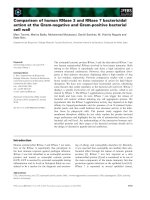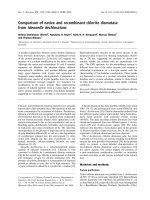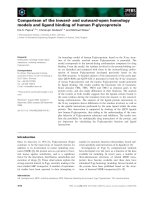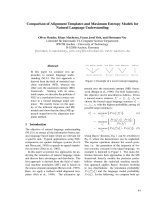Báo cáo khoa học: " Comparison of two sap flow methods for the estimation of tree transpiration" ppt
Bạn đang xem bản rút gọn của tài liệu. Xem và tải ngay bản đầy đủ của tài liệu tại đây (307.71 KB, 7 trang )
Original
article
Comparison
of
two
sap
flow
methods
for
the
estimation
of
tree
transpiration
Régis
Tournebize*
Stéphane
Boistard
Unité
de recherche
Agropédoclimatique,
Inra,
Centre
Antilles-Guyane,
BP
515,
97165
Pointe-à-Pitre
cedex,
France
(Received
3
December
1996;
revised
10
March
1997;
accepted
20
December
1997)
Abstract -
The
purpose
of
this
note
is
to
compare
two
sap
flow
methods
for
estimation
of
trans-
piration
on
the
tropical
tree
Gliricidia
sepium.
The
first
one
is
based
on
heat
dissipation
around
a
heater
probe,
and
the
second
is
based
on
complete
stem
energy
balance.
Under
our
conditions,
no
significant
differences
between
daily
transpiration
measurements
were
shown
using
the
radial
fluxmeter
method
and
the
heat
balance
method.
Thus,
these
two
methods
can
be used
alternately
or
in
a
complementary
way
according
to
their
specific
advantages.
(©
Inra/Elsevier,
Paris.)
transpiration
/
sapflow
/
radial
fluxmeter/
energy
balance
/
Gliricidia
sepium
Résumé -
Comparaison
de
deux
méthodes
de
flux
de
sève
pour
l’estimation
de
la
transpira-
tion
d’arbres.
Deux
méthodes
de
flux
de
sève
on
été
comparées
sur
des
arbustes
tropicaux
(Gliricidia
sepium).
La
première
méthode
consiste
à
suivre
la
dissipation
de
chaleur
d’une
sonde
chauffante,
et
la
seconde
est
basée
sur
l’établissement
d’un
bilan
d’énergie
complet
d’une
portion
de
tige.
Dans
nos
conditions
et
durant
plus
de
dix
jours,
aucune
différence
significative
de
trans-
piration
journalière
n’a
été
trouvée
entre
la
première
méthode
du
fluxmètre
radial
et
la
seconde
du
bilan
de
chaleur
d’une
section
de
tige.
Les
deux méthodes
peuvent
donc
s’utiliser
indifférement
ou
de
façon
complémentaire
en
fonction
de
leurs
avantages
respectifs.
(©
Inra/Elsevier,
Paris.)
transpiration
/
flux
de
sève
/
fluxmètre
radial / bilan
de
chaleur
/
Gliricidia
sepium
*
Correspondence
and
reprints
E-mail:
1.
INTRODUCTION
A
good
knowledge
of
crop
water
cycle
is
required
to
manage
cropping
systems,
particularly
under
limited
conditions.
To
evaluate
the
productivity
or
the
adaptabil-
ity
of
a
species
to
different
environmental
and
technical
conditions,
knowledge
on
transpiration
is
needed.
Transpiration
can
be
estimated
or
measured
using
several
methods.
Application
of
micrometeoro-
logical
methods
for
example
is
not
possi-
ble
under
particular
conditions,
such
as
small
area,
steep
slope
or
sparse
canopy.
The
in
situ
measurement
by
sap
flow
techniques
is
the
only
way,
and
different
techniques
exist [11].
The
basis
of
the
use
of
energy
budget
to
measure
sap
flow
was
established
by
Sakuratani
[10].
The method
is
now
widely
used
[1, 6,
7].
Later
a
simplified
method
based
on
the
same
principle
of
energy
dissipation
by
conduction
and
convection
with
sap
flow
per
unit
of
sap-
wood
area
was
suggested
by
Granier
[4].
Both
methods
have
been
tested
and
validated
separately
[4,
10].
They
present
specific
characteristics
for
their
utilisa-
tion
with
regards
to
adaptability
to
stem
diameter,
energy
requirements,
connec-
tions
to
a
datalogger,
etc.
Moreover,
due
to
the
different
advantages
and
disadvan-
tages
(table
I),
it
is
interesting
to
use
the
two
methods
in
a
complementary
way
and
also
to
compare
the
results
from
the
same
stem.
In
this
note,
a
comparison
of
the
two
methods
on
the
same
trunk
has
been
reported.
2.
MATERIALS
AND
METHODS
The
measurements
were
made
on
two
2-
year-old
Cliricidia
sepium
trees
managed
in
alley
crop
with
Pangola
grass
(Digitaria
decumbens).
The
trunk
diameter
was
0.04
m
and
the
height
1 m. Granier’s
sensors
were
set
at
the
bottom
of
the
trunk
at
about
0.4
m
from
the
soil
(method
1).
A
home-made
gauge
for
the
energy
balance
method
was
fitted
on
the
top
(method
2).
The
comparison
was
made
during
I
days
in
1994
using
the
two
tech-
niques
alternately
or
simultaneously
as
shown
in
table
II.
2.1.
Description
of
methods
2.1.1.
Method
1
Method
1
proposed
by
Granier
[4]
con-
sisted
of
two
cylindrical
probes
of
2
mm
in
diameter,
which
were
inserted
0.02
m
into
the
sapwood
of
the
bole,
one
above
the
other
(0.2
m).
The
upper
probe
contained
a
constan-
tan
heating
element
which
was
heated
at
con-
stantan
power.
Each
probe
contained
a
cop-
per-constant
an
thermocouple,
connected
together
in
opposition,
in
order
to
measure
temperature
difference.
The
latter
was
influ-
enced
by
the
sap
flow
density
u.
Sap
flow
was
calculated
with
the
following
equation:
where
F
is
the
sap
flow
(L.h
-1),
SA
the
sap-
wood
area
at
the
level
of
heated
probe
(cm
2
),
and
K
the
flow
index
(dimensionless):
where
ΔTM
is
the
temperature
difference
between
probes
without
any
sap
flow
(K)
and
ΔT(u)
is
the
temperature
difference
with
sapflow
u
(K).
The
sensors
can
be
built
as
described
by
Granier
[4]
or
purchased
(UP
GmbH,
Schirmgasse,
D-84028
Landshut)
and
present
some
specificities
(table
I).
Low
electric
power
of
0.2
W
is
used
whatever
the
stem
diameter.
Therefore
this
method
is
particularly
adapted
to
large
diameter
trees
up
to
0.6
m
[5].
Only
one
differential
temperature
mea-
surement
with
datalogger
is
required
if
the
intensity
is
precisely
known
and
constant,
oth-
erwise
two.
Sapwood
area
must
be
known.
It
is
estimated
by
dye
impregnation
of
wood
and
stemcores
[5].
The
precision
in
the
estimation
of
the
transpiration
depends
on
the
accuracy
of
the
differential
temperature
measurement.
The
thermocouples
must
be
protected
against
direct
radiation.
In
the
case
of
our
installation
with
home-
made
Graniers
probe
close
to
the
soil
surface,
it
is
important
to
take
into
account
the
natural
temperature
gradient
between
the
two
probes
without
any
heating.
This
gradient
is
due
to
soil
conduction
along
the
trunk
and
wood
heat
capacity.
This
difference
is
less
than 0.15
K,
against
values
of
3.8
K
during
night
period
of
heating.
The
difference
recorded
during
days
without
any
artificial
heating
was
deduced
from
measured
gradient,
in
order
to
take
into
account
the
natural
gradient.
The
adjusted
daily
transpiration
was
3
%
higher
than
direct
measurement
and
evolves
at
the
same
pace
as
photosynthetically
active
radiation.
2.1.2.
Method
2
Method
2
is
more
complete
and
is
based
on
the
energy
balance
of
a
part
of
the
stem
as
described
by
Sakuratani
[10],
Valancogne
and
Nasr
[12]
and
van
Bavel
and
van
Bavel
[3].
This
method
has
been
tested
and
validated
on
G. sepium
trees
[9].
The
apparatus
consists
of
a
flexible
heater
encircling
the
stem
and
providing
a
small
steady
and
known
amount
of
heat
(Pin).
The
heated
segment
is
insulated.
The
outward
heat
flow
is
partitioned
into
three
conductive
fluxes:
up
and
down
the
stem
(Qv),
radial
conduction
into
the
insulation
(Qr)
and
mass
heat
transport
by
the
sap
stream
(Qf).
As
shown
previously
[9,
6,
7]
heat
stor-
age
is
not
taken
into
account
in
our
case
due
to
small
considered
volume
and
tropical
steady
state
temperature
conditions.
Pairs
of
thermocouples
inserted
above
and
below
the
heater
allow
the
measurement
of
the
conduction
flux
(Qv).
The
radial
outward
flow
(Qr)
is
calculated
from
thermopile
mea-
surements.
The
thermopile
was
composed
of
four
thermojunctions
in
series,
located
on
either
side
of
a
2
mm
thick
rubber.
The
sheath
conductance
of
the
gauge
is
calculated
during
the
night
when
no
sap
flow
occurs
between
2300
and
0400
hours.
The
sap
flow
rate
(F)
is
calculated
as
fol-
lows
[2,
10]:
where
Cp
is
the
heat
capacity
of
the
xylem
sap
and
dT
the
temperature
increase
of
the
sap
through
the
heater.
This
apparatus
can
be
made
as
described
by
Sakuratani
[10]
or
is
commercially
avail-
able
by
Dynamax
Inc.,
Houston,
Texas.
In
our
case,
it
requires
five
connections
to
our
data-
logger
and
an
energy
source
of
0.64
W.
Table
I
summarises
the
advantages
and
disadvan-
tages
of
the
method.
The
methods
were
applied
successively
or
simultaneously
as
showed
in
table
II.
A
21X
datalogger
(Campell
Scientific,
1420
Field
Street
Shepshed,
LE129AL,
UK)
scanned
the
sensors
every
10
s
and
recorded
average
val-
ues
every
15
min.
3.
RESULTS
AND
DISCUSSION
Both
methods
appeared
to
be
reliable,
and
were
used
without
any
problems
dur-
ing
the
experiment.
Sap
flow
showed
maximum
daily
val-
ues
ranging
from
0.15
to
0.25
L.h
-1
.tree
-1
according
to
the
climatic
demand.
These
variations
were
princi-
pally
caused
by
the
variation
of
air
vapour
pressure
deficit
[5],
and
seem
more
stable
than
PAR
fluctuations.
Some
difference
could
be
caused
by
the
effect
of
shadow
due
to
the
row
structure.
Sap
flow
density
was
about
2
kg.dm
-2.h-1
and
was
similar
to
those
pre-
viously
measured
in
Guadeloupe
[9]
and
French
Guyana
[5].
This
density
repre-
sented
about
0.5
mm.day
-1
of
transpira-
tion
for
a
LAI
of
0.5
and
was
comparable
with
values
observed
by
Leroux
[8]
in
Lamto
savanna
(Ivory
Coast).
Method
1
was
quite
easy
to
use
owing
to
the
easy
control
of
the
sensors,
the
low
energy
needs
and
the
low
number
of
data-
logger
connections.
The
transpiration
was
calculated
on
the
basis
of
sapwood
area
which
represented
90
%
of
the
cross-
sectional
area
at
the
heating
probe
level.
The
last
10
%
corresponded
to
heart
wood
and
to
the
central
medulla.
As
in
the
second
method,
the
rate
of
transpiration
showed
large
variations
between
consecutive
measurements.
These
variations
were
probably
due
to
the
short
measuring
time
interval
(15
min)
and
the
influence
of
direct
radiation
close
to
the
temperature
probe,
even
with
the
shield.
This
event
could
be
particularly
important
in
the
case
of
an
isolated
tree,
or
in
an
orchard
owing
to
sun
course.
Method
2
was
successfully
used
and
produced
good
results
on
G.
sepium
[9].
Both
methods
worked
well
without
interferences
as
shown
in
figure
1.
Respective
functioning
of
each
method
was
not
deteriorated
by
the
other.
The
relationship
obtained
with
the
comparison
of
the
two
methods
over
the
whole
period
(n
=
589)
is
presented
in
figure
2.
The
slope
of
the
regression
line
was
0.98
and
the
determination
coeffi-
cient
0.89.
Residuals,
with
a
mean
of
8.4.10
-4
l.h
-1
showed
a
very
good
agree-
ment
between
the
two
methods.
At
the
scale
of
a
quarter
of
an
hour,
the
difference
between
the
two
transpiration
reached
30
%
and
some-
times
more
than
100
%
for
some
points
corresponding
to
low
transpiration
rate,
particularly
in
the
morning.
This
differ-
ence
decreased
by
less
than
20
%
at
the
hourly
scale.
In
a
daily
scale,
the
maxi-
mum
difference
was
registered
during
the
first
2
days
of
the
experiment
and
reached
8
%,
probably
due
to
the
time
necessary
to
obtain
the
steady
state
condition.
The
average
of
differences
was
about
4.5
%
for
trees
1
and
2.
No
physical
explanation
could
account
for
these
differences.
4.
CONCLUSION
This
experiment
showed
an
accuracy
of
greater
than
10
%
for
the
two
methods,
when
comparing
daily
fluxes
from
the
two
methods
of
sap
flow
measurement.
At
an
hourly
rate,
the
difference
could
reach
20
%,
particularly
for
the
small
amount
of
transpiration
in
the
morning.
This
study
confirmed
the
possibility
of
using
one
or
the
other
method
in
accor-
dance
with
the
objectives,
and
the
equip-
ment.
The
major
problem
is
still
the
choice
of
samples
required
for
an
accu-
rate
estimation
of
transpiration.
The
combination
of
the
two
methods
seems
possible
in
the
same
experiment.
The
heat
balance
for
the
small
trunks,
and
transpiration
calculation
for
small
periods
and
Granier’s
method
for
the
large
ones
and
at
a
daily
scale,
without
problems
of
sap
flow
measure
compatibility.
REFERENCES
[1]
Allen
S.J.,
Grime
V.L.,
Measurements
of
transpiration
from
savannah
shrubs
using
sap
flow
gauges,
Agric.
For.
Meteorol.
75
(1995)
23-41.
[2]
Baker
J.M.,
Van
Bavel
C.H.M.,
Measurement
of
mass
flow
of
water
in
the
stems
of
herbaceous
plants,
Plant
Cell
Env.
10
(1987)
777-782.
[3]
van
Bavel
M.G.
van
Bavel
C.H.M.,
DynagageTM
Installation
and
Operation
Manual,
Dynamax Inc.,
1990,
80
p.
[4]
Granier
A.,
Une
nouvelle
méthode
pour
la
mesure du
flux
de sève
brute
dans
le tronc des
arbres,
Ann.
Sci.
For.
42
(1985)
81-88.
[5]
Granier
A., Huc
R., Barigah
S.T.,
Transpiration
of
natural
rain
forest
and
its
depen-
dence
on
climatic
factors,
Agric.
For.
Meteorol.
78
(1996)
19-29.
[6]
Grime
V.L.,
Morison
J.I.L.,
Simmonds
L.P.,
Including
the
heat
storage
term
in
sap
flow
mea-
surements
with
the
stem
heat
balance
method,
Agric.
For.
Meteorol.
74
(1995a)
1-25.
[7]
Grime
V.L.,
Morison
J.I.L.,
Simmonds
L.P.,
Sap
flow
measurements
from
stem
heat
balances:
a
comparison
of
constant
with
variable
power
meth-
ods,
Agric.
For.
Meteorol.
74
(1995b)
27-40.
[8]
Leroux
X.,
Étude
et
modelisation
des
échanges
deau
et
dénergie
sol-végétation-atmo-
sphère
dans
une
savane
humide
(Lamto,
Côte-
d’lvoire),
thèse
Université
Paris
VI,
1995, 203 p
+
annexes.
[9]
Ozier-Lafontaine
H.,
Tournebize
R.,
Mesure
des
flux
de
sève
par
bilan
thermique
appliquée
à
lestimation de
la
transpiration
dun
arbuste
(Gliricidia
sepium)
et
dun
peuplement
de
canne
à
sucre
(Saccharum
officinarum)
Cahiers
Agriculture,
2 (1993) 197-206.
[10]
Sakuratani
T.,
A
heat
balance
method
for
measuring
water
flow
in
the
stem
of
intact
plant,
J.
Agric.
Meteorol.
37
(1981)
9-17.
[11]
Swanson
R.H.,
Significant
historical
devel-
opments
in
thermal
methods
for
measuring
sap
flow
in
trees,
Agric.
For.
Meteorol.
72
(1994)
113-132.
[12]
Valancogne
C.,
Nasr
Z.,
Une
méthode
de
mesure
du
débit
de
sève
brute
dans
de
petits
arbres
par
bilan
de
chaleur,
Agronomie
9
(1989)
609-617.
